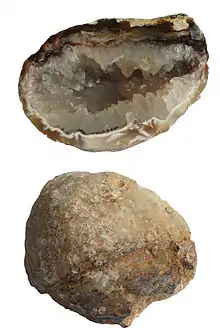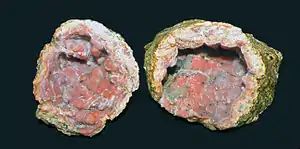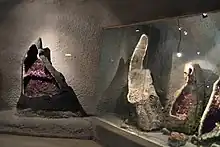Geode
A geode (/ˈdʒiː.oʊd/; from Ancient Greek γεώδης (geṓdēs) 'earthlike') is a geological secondary formation within sedimentary and volcanic rocks. Geodes are hollow, vaguely spherical rocks, in which masses of mineral matter (which may include crystals) are secluded. The crystals are formed by the filling of vesicles in volcanic and subvolcanic rocks by minerals deposited from hydrothermal fluids; or by the dissolution of syn-genetic concretions and partial filling by the same or other minerals precipitated from water, groundwater, or hydrothermal fluids.

Formation
Geodes can form in any cavity, but the term is usually reserved for more or less rounded formations in igneous and sedimentary rocks. They can form in gas bubbles in igneous rocks, such as vesicles in basaltic lava; or, as in the American Midwest, in rounded cavities in sedimentary formations. After rock around the cavity hardens, dissolved silicates and/or carbonates are deposited on the inside surface. Over time, this slow feed of mineral constituents from groundwater or hydrothermal solutions allows crystals to form inside the hollow chamber. Bedrock containing geodes eventually weathers and decomposes, leaving them present at the surface if they are composed of resistant material such as quartz.[1]
When cut in half, visible bands corresponding to varied stages of precipitation may at times show patterns that reveal points of fluid entry into the cavity and/or varied colors corresponding to changes in chemistry.
Coloration

Geode banding and coloration is the result of variable impurities. Iron oxides will impart rust hues to siliceous solutions, such as the commonly observed iron-stained quartz. Most geodes contain clear quartz crystals, while others have purple amethyst crystals. Still others can have agate, chalcedony, or jasper banding or crystals such as calcite, dolomite, celestite, etc. There is no easy way of telling what the inside of a geode holds until it is cut open or broken apart. However, geodes from a particular area are usually similar in appearance.
Geodes and geode slices are sometimes dyed with artificial colors.[2] Samples of geodes with unusual colors or highly unlikely formations have usually been synthetically altered.
Occurrence
Geodes are found where the geology is suitable with many of the commercially available ones coming from Brazil, Uruguay, Namibia, and Mexico.[1] Large, amethyst-lined geodes are a feature of the basalts of the Paraná and Etendeka traps found in Brazil, Uruguay and Namibia. Geodes are common in some formations in the United States (mainly in Indiana, Iowa, Missouri, western Illinois, Kentucky, and Utah). Geodes are also abundant in the Mendip Hills in Somerset, England, where they are known locally as "potato stones".[3] The term geode generally describes hollow formations. If the rock is completely solid inside, this would be classified as a nodule or thunderegg.[4]
Crystal caves

'Crystal cave' is both an informal term for any large crystal-lined geode and also used for specific geoheritage locations such as the Crystal Cave (Ohio), discovered in 1887 at the Heineman Winery on Put-In-Bay, Ohio, the Cave of the Crystals (Mexico), and the Pulpi Geode, discovered in 1999 in Spain. In 1999, a mineralogist group discovered a cave filled with giant selenite (gypsum) crystals in an abandoned silver mine, Mina Rica, near Pulpi, Province of Almeria, Spain. The cavity, which measured 8.0 by 1.8 by 1.7 metres (26.2 ft × 5.9 ft × 5.6 ft), was, at the time, the largest crystal cave ever found. Following its discovery, the entrance to the cave was blocked by five tons of rock, with an additional police presence to prevent looters. In the summer of 2019 the cave, a significant geotourism resource and now named the 'Geoda de Pulpi', Pulpi Geode, was opened as a tourist attraction, allowing small groups (max. 12 people) to visit the caves with a tour guide.[5]
References
- "Geodes: The rocks with a crystal surprise inside!". geology.com. Retrieved 2017-12-30.
- "Geodes". geology.com.
- "The Quarries". Dulcote, Somerset. Retrieved 2017-12-30.
- "Definition of Geode". Mindat. Retrieved 2023-05-22.
- "Geoda de Pulpi". Retrieved 1 September 2022.
Further reading
- Pough, Fredrick H. Rocks and Minerals, ISBN 0-395-91096-X
- Middleton, Gerard V. (2003). Encyclopedia of Sediments and Sedimentary Rocks. Springer, ISBN 978-1-4020-0872-6, p. 221 (restricted online copy, p. 221, at Google Books)
- Keller, Walter David (1961). The Common Rocks and Minerals of Missouri. University of Missouri Press, ISBN 978-0-8262-0585-8, S. 67 (restricted online copy, p. 67, at Google Books)
- Witzke, Brian J. Geodes: A Look at Iowa's State Rock. Iowa Geological Survey
- Geodes Kentucky Geological Survey (University of Kentucky)
External links
- Indiana geode specimens, facts and stories
- Video of a geode cracking using industrial soil pipe cutter
- Australian Museum Fact sheet
- Utah Geode Beds
- Illinois State Geological Survey. "Geodes – Small Treasure Vaults in Illinois" (PDF). Archived from the original (PDF) on 2007-09-27.